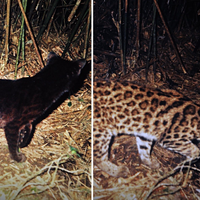Login
Subscribeanimal communication

Opinion: Listening to the Biosphere Is Key Step in Saving It
Karen Bakker | Dec 12, 2022 | 4 min read
New insights into the functionality of nonhuman sound may help us conserve nature and protect ourselves from excessive noise.

Turtle Vocalizations Reframe Origins of Auditory Communication
Amanda Heidt | Oct 26, 2022 | 4 min read
Sounds made by more than 50 vertebrates previously thought to be mute push back the origin of this type of communication by at least 100 million years, a study finds.

Listen to Extinct Crickets Chirp
David George Haskell | May 16, 2022 | 4 min read
The land’s first known singer may have sounded like a raspier version of today’s familiar insect fiddlers.

Book Excerpt from Sounds Wild and Broken
David George Haskell | May 16, 2022 | 5 min read
In a chapter entitled “Predators, Silence, Wings,” author David George Haskell explores the soundscapes of bygone eras of animal communication.

Exposure to Chemical from Babies Linked to Aggression
Chloe Tenn | Nov 22, 2021 | 3 min read
A study finds that the odorless compound hexadecanal, or HEX, increases aggressive behavior in women but has a calming effect on men.

Cleaner Fish Alter Behavior if Partners Can See Them “Cheating”
Chloe Tenn | Oct 7, 2021 | 4 min read
A study of feeding behavior suggests the fish feed differently in front of their partners—a behavioral feature also found in primates.

Baby Talk: Bat Pups Babble Like Human Infants
Annie Melchor | Aug 20, 2021 | 4 min read
By studying the vocal behavior of 20 baby bats from birth to weaning, researchers have identified striking similarities between how young humans and bats develop communication skills.

Naked Mole Rat Colonies Have Their Own Unique Dialects
Amanda Heidt | Feb 4, 2021 | 6 min read
Chirp dialects appear to be enforced by the colony’s queen, but scientists aren’t sure how.

Zebra Finches Recognize the Calls of Over 40 Fellow Finches
Amanda Heidt | Nov 13, 2020 | 5 min read
Their ability to distinguish between individuals is strong evidence for fast mapping, a learning tool generally thought to belong only to humans.

Image of the Day: Black Cats
Emily Makowski | Dec 19, 2019 | 2 min read
Melanism in felines is both helpful and harmful.

Squirrels Listen to Birdsong for Safety Cues
Emily Makowski | Sep 5, 2019 | 2 min read
Eastern gray squirrels appear to ease up on vigilance behavior when the birds sound calm.

Image of the Day: Fluorescent Sharks
Nicoletta Lanese | Aug 13, 2019 | 1 min read
A newfound family of metabolites emits green light in response to the blue light of the deep ocean, causing certain sharks to glow.

Browsing Deer Affect How A Forest Sounds
Jef Akst | Jun 1, 2019 | 3 min read
Changes in the auditory environment as a result of herbivory could influence how animals communicate, and may have implications for sound-based monitoring of species.

Suit Filed to Stop Seismic Airgun Blasting in Atlantic Ocean
Ashley Yeager | Dec 12, 2018 | 2 min read
Eight environmental groups took the legal measure in an effort to protect North Atlantic right whales and other marine organisms.

Starfish in the Deep Sea Can See
Abby Olena, PhD | Feb 6, 2018 | 3 min read
A study of 13 starfish species reveals that even animals that live at depths where sunlight doesn’t reach have functioning eyes.

Song Around the Animal Kingdom
The Scientist Staff | Mar 1, 2017 | 3 min read
Diverse species are said to sing, but music is in the ear of the beholder.

Birds May Make Music, But They Lack Rhythm
Jenny Rood | Mar 1, 2017 | 3 min read
Birdsong bears a striking resemblance to human music, but it’s not yet clear that birds interpret it that way.

Bats Sing Sort of Like Birds
Bob Grant | Mar 1, 2017 | 3 min read
Some bat vocalizations resemble bird songs, though at higher frequencies, and as researchers unveil the behaviors’ neural underpinnings, the similarities may run even deeper.

Researchers Study Rodent Songs They Can’t Hear
Joshua A. Krisch | Mar 1, 2017 | 3 min read
Mice and rats produce ultrasonic signals to attract mates.
